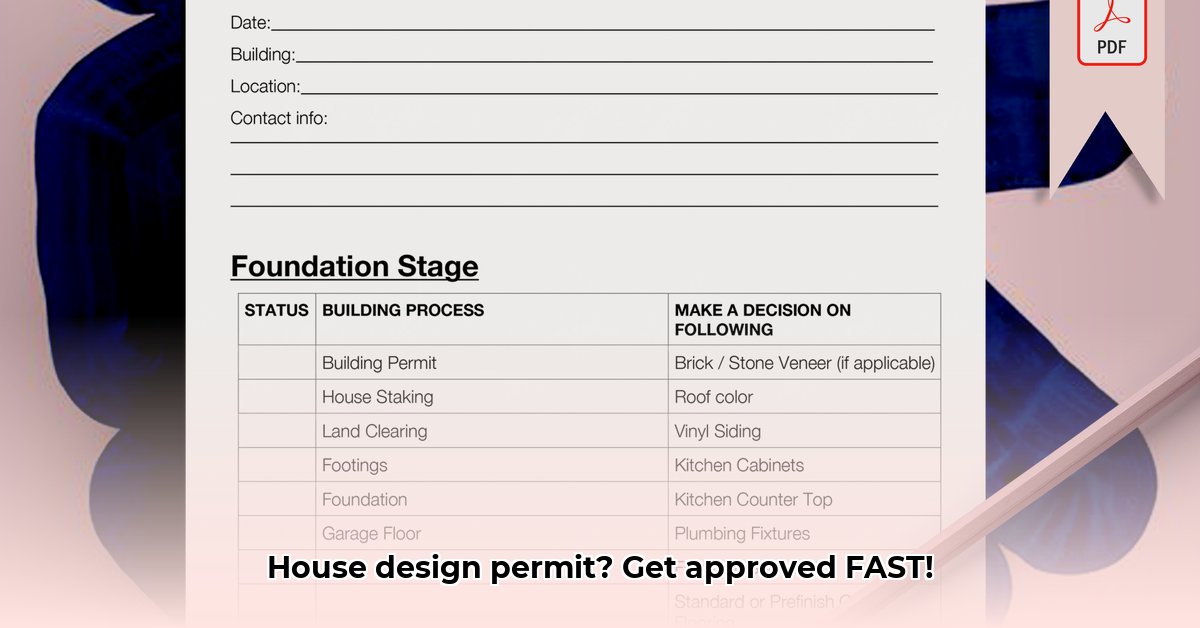Ready to build your dream house? Before you break ground, there’s one important thing you need: building permits. Sounds complicated? It doesn’t have to be! This guide walks you through the whole process, step-by-step, making it easy to understand and avoid common pitfalls. We’ll show you exactly how to gather all the necessary documents, complete the application, and even provide a handy checklist to keep you on track. Think of us as your personal permit assistants, helping you navigate the local rules and regulations so you can focus on building your amazing new home. For additional help with your floor plans, check out this helpful resource on floor plan requirements. Let’s get started!
Building Permit Basics: Your Fast-Track to Approval
Dreaming of building your own home? Fantastic! But before you break ground, you’ll need building permits. Sounds daunting? It doesn’t have to be. This guide walks you through the process, making it easier than you think. We’ll demystify the paperwork and help you get those permits approved quickly, ensuring you’re one step closer to your dream home. This comprehensive resource covers everything from understanding zoning regulations to compiling your permit application and provides essential tips for avoiding common delays.
Decoding Local Zoning Regulations
Before you even begin sketching your dream house, you must understand the local regulations and zoning compliance. Every area has specific zoning rules and building codes – think of them as the “rules of the game.” These rules dictate what you can (and can’t) build on your land, including things like setbacks from property lines, building height limits, maximum lot coverage, and the type of materials you can use. Some zoning regulations might even specify architectural styles or landscaping requirements.
Skipping this crucial step is a recipe for delays, increased costs, and potential legal headaches down the line. Start by searching online for “[your city/county] zoning regulations” – you’ll likely find all the information you need on your local government’s website. You can also visit the planning and building department in person. Understanding these regulations is the first step toward a smooth and successful building project. Familiarize yourself with terms like:
- Setbacks: The minimum distance a building must be from property lines.
- Lot Coverage: The percentage of your property that can be covered by structures.
- Floor Area Ratio (FAR): The ratio of a building’s total floor area to the size of the land upon which it is built.
- Easements: Legal rights granted to others to use a portion of your property (e.g., utility easements).
- Height Restrictions: Maximum allowable height for buildings.
Navigating the Permit Application Process
Let’s break down the permit application process into easy-to-follow steps, ensuring you understand each component. It’s much less scary than it sounds.
-
Pre-Application Meeting (Optional but Recommended): Many building departments offer pre-application meetings where you can discuss your project with a building official. This is a great opportunity to ask questions, clarify requirements, and identify potential issues early on.
-
Gather Your Information: The Foundation of Your Application: Start with the essentials: property details (legal description, address, lot size), a detailed site plan showing the house’s location on the lot, and your preliminary house plans. Think of this as the groundwork for your application. The clearer this information, the smoother the process will likely be.
-
Complete the Application: Accuracy is Key: Your local building department is your source for the permit application forms. Fill them out with precision – accuracy is paramount. Even small errors can delay your application. Take your time. Double-check everything before submitting. Ensure all fields are completed and all necessary signatures are obtained.
-
Assemble Your Documents: The Checklist is Your Best Friend: This is where your permit checklist (below) comes in handy. It’s essentially your “to-do” list for documents. You’ll likely need things like site plans, surveys (showing property boundaries), architectural drawings (detailed plans of your house with floor plans, elevations, and sections), structural calculations (ensuring the house’s stability), and potentially specialized engineering reports for things like plumbing, mechanical (HVAC), electrical, or fire protection systems. Some jurisdictions might also need an energy efficiency report or environmental impact assessment. Did you know incomplete applications are a leading cause for permit delays?
-
Submit Your Application: Get It In! Once your application and all supporting documents are complete, submit them to the building department. This might involve an in-person visit, mailing, or online submission, depending on your local process. Many places offer online submissions now, which is often faster and more convenient. Remember to pay the applicable fees! It is also advisable to keep copies of everything for your own records – you’ll want to have access to this information throughout the construction process.
-
Review Process: After submission, your application will be reviewed by various departments within the building department (e.g., zoning, structural, plumbing, electrical). They will check for compliance with all applicable codes and regulations.
-
Corrections and Revisions: It’s common for the building department to request corrections or revisions to your plans. Address these comments promptly and resubmit the corrected plans. Clear communication with the reviewers can expedite this process.
-
Permit Issuance: Once your application is approved and all fees are paid, you will receive your building permit. This permit must be posted on the construction site and readily visible to inspectors.
-
Inspections: Throughout the construction process, you will need to schedule inspections at various stages (e.g., foundation, framing, plumbing, electrical, final inspection). These inspections ensure that the work is being done in accordance with the approved plans and building codes.
-
Certificate of Occupancy: Once all inspections are completed and approved, you will receive a Certificate of Occupancy (CO), which signifies that your building is safe and ready for occupancy.
Your Essential Permit Checklist for House Design
This is a sample checklist; your specific requirements may vary depending on your location and project scope. Always confirm your needs with your local building department and confirm proper filing procedures.
| Document Type | Description | Important Notes |
| :——————————————— | :————————————————————————————————— | :———————————————————————————————————————————————————————————- |
| Application Form | The official form from your building department. | Fill it out completely and accurately. Ensure all required signatures are obtained. |
| Property Survey | Shows your property lines, measurements, and any easements. | Ensure it’s current (usually within the last year) and accurately reflects your property boundaries. |
| Site Plan | Illustrates your house’s placement on the lot, distances from property lines, existing structures, etc. | Detail is key; inaccuracies can lead to delays or rejections. Show all easements, setbacks, and proposed landscaping. |
| Architectural Drawings | Detailed blueprints: floor plans, elevations, sections, etc. | Typically need to be sealed by a licensed architect or engineer. Include detailed dimensions, materials specifications, and window/door schedules. |
| Structural Engineering Calculations | Proof that the structure will be safe and strong. | Prepared by a licensed structural engineer. Include calculations for foundations, walls, roofs, and beams. |
| Soils Report | Report on soil conditions and bearing capacity. | May be required in areas with unstable soil or a high water table. |
| Engineering Reports (Plumbing, Electrical, HVAC) | Plans for plumbing, electrical, HVAC, and fire protection systems, showing compliance with codes. | Requirements vary significantly based on local regulations and project specifics. Ensure these plans are prepared by licensed professionals. |
| Energy Efficiency Calculations | Demonstrates your home meets energy-efficiency requirements. | Increasingly common to ensure compliance with energy standards. May involve using specific software or following prescriptive requirements. |
| Environmental Impact Assessment | Assessment of the project’s potential impact on the environment. | May be required for projects in sensitive areas or those that exceed certain size thresholds. |
| Homeowners Association (HOA) Approval | Approval from your HOA, if applicable. | Obtain written approval from your HOA before submitting your permit application. |
| Demolition Permit (if applicable) | Permit required to demolish existing structures. | Ensure all utilities are disconnected before demolition. |
(A downloadable PDF of a more comprehensive checklist is available upon request. Contact your local building department for assistance.)
Avoiding Common Permitting Pitfalls
- Incomplete Applications: This is the number one reason for delays. Thoroughly review your application and all supporting documents before submission. Use your checklist meticulously.
- Ambiguous or Incomplete Drawings: Clear, professional-quality drawings are essential. Vague or unclear plans will probably result in delays or rejections. Ensure all dimensions are accurate and legible.
- Overlooking Local Regulations: Familiarize yourself with the local building codes before getting started. Ignoring these regulations is a recipe for disaster. Attend a pre-application meeting to clarify any questions.
- Poor Communication: Maintain open communication with the building department – addressing questions promptly avoids unnecessary delays. Respond to requests for information quickly and professionally.
- Backsplash For Cooktop: Stylish Ideas To Protect and Enhance - December 25, 2025
- Stove Backsplash Ideas: Find Your Perfect Kitchen Style - December 24, 2025
- Stovetop Backsplash Ideas: Stylish Protection for Your Kitchen Cooking Zone - December 23, 2025










